The Bay Trail Preview: Intel Atom Z3770 Tested
by Anand Lal Shimpi & Brian Klug on September 11, 2013 12:00 PM EST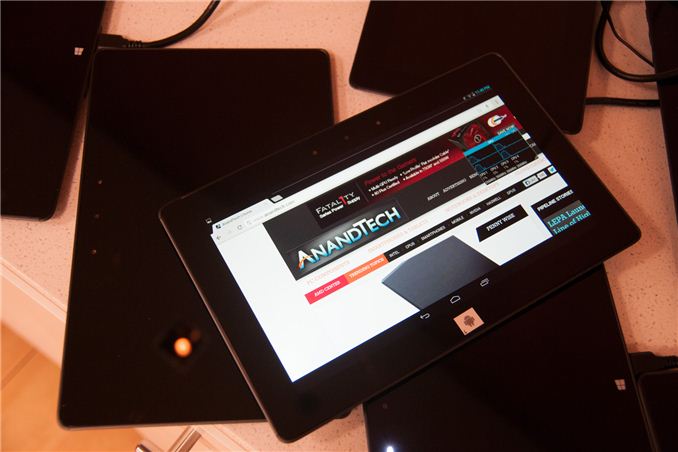
Earlier this year Intel unveiled Silvermont, its first true architectural update to Atom since its introduction in 2008. I won’t rehash Silvermont’s architecture here, but it’s designed to be a true test of Intel’s performance in the ultra mobile space. Leveraging Intel’s first 22nm SoC process and a very low power/efficient microarchitecture, Silvermont aims squarely at the latest Krait cores from Qualcomm and ARM’s Cortex A15.
Today Intel takes the next step forward, introducing the first tablet SoC based on Silvermont: Bay Trail.
Bay Trail takes up to four Silvermont cores, and for the first time in an ultra mobile Intel SoC pairs them with Intel’s own graphics IP. That’s right, rather than using a GPU block from Imagination Technologies, Bay Trail leverages the same GPU architecture as Ivy Bridge.
The first Bay Trail tablets will be shipping by the end of the year, across both Android and Windows 8.1. Intel expects Bay Trail to show up in tablets and 2-in-1s priced below $599, with everything above $599 falling under Haswell’s jurisdiction.
Bay Trail & Branding
Bay Trail, like all Atom platforms before it, will be available in multiple form factors. Unlike the Atoms of yesterday however, the SoC will carry Pentium and Celeron branding when used in notebooks and desktops. Intel didn’t disclose too much about its Silvermont plans in other form factors other than some basic naming:
Basically notebooks ship under the Pentium N3000 & Celeron N2000 series, while desktops will carry Pentium J2000 & Celeron J1000 branding. All Pentium SKUs seem to be quad-core, while Celeron SKUs will be available in both dual and quad-core versions.
Thankfully Intel shied away from introducing the same complexity with its tablet focused Bay Trail parts. All Bay Trail tablet SKUs carry Atom branding. There’s the quad-core Z3700 series and the dual-core Z3600 series.
Although Intel offers both dual and quad-core Bay Trail SKUs, they are both based on the same single physical design. In other words, dual-core Bay Trail parts are just die harvested quad-core parts. Intel isn’t disclosing die size or transistor counts, which is ironic (and disappointing) given that Apple just disclosed both (or at least relative magnitude of one) for its A7 SoC.
Internally, the Bay Trail design is pretty nice. There are either two or four cores enabled, each pair with a shared 1MB L2 cache (2MB total for a quad-core part). Intel is following the unfortunate lead of everyone else in the mobile industry and advertising max turbo frequencies exclusively.
Thankfully Intel hasn’t yet decided to obfuscate max non-turbo frequencies:
| Bay Trail Turbo Speeds | ||||||||
| Z3770 | Z3770D | Z3740 | Z3740D | Z3680 | Z3680D | |||
| Max turbo frequency | 2.39GHz | 2.41GHz | 1.86GHz | 1.83GHz | 2.0GHz | 2.0GHz | ||
| Max non-turbo Frequency | 1.46GHz | 1.5GHz | 1.33GHz | 1.33GHz | 1.33GHz | 1.33GHz | ||
In general you’re looking at 1.33GHz - 1.46GHz max non-turbo frequencies, with Bay Trail being able to turbo up to anywhere between 1.83GHz and 2.40GHz depending on SKU.
Although the core architecture is 64-bit in design, there will be no OS support for 64-bit Bay Trail at launch. Windows 8.1 with Connected Standby appears to still be 32-bit only, and obviously Android is 32-bit only at this point as well.
The memory interface is fairly ridiculous by mobile standards. You either get two 64-bit LPDDR3 channels (128-bit total width) or a single 64-bit DDR3L channel. In the case of the former, that’s the same memory bus width as Apple’s A5X/A6X line of SoCs as well as the standard Core i3/i5/i7 parts. Max supported memory frequency is 1066MHz in dual-channel LPDDR3 mode, or 1333MHz in single-channel DDR3L mode. The only benefit to the latter is really cost, as Bay Trail will purportedly show up in some very cheap devices.
The GPU is Intel’s own Gen7 graphics core, a cut down implementation of what we first saw in Ivy Bridge. I suppose it’s premature to expect Merrifield, Bay Trail’s smartphone counterpart, to also use Intel’s own graphics core but it’s clear this is the direction Intel is headed in - and away from licensing IP from Imagination Technologies.
Rather than 16 EUs in the Ivy Bridge GT2 configuration (HD 4000), Bay Trail’s HD Graphics core ships with 4. The 4 EUs are otherwise effectively identical to what we found in Ivy Bridge. The GPU can dynamically scale frequency and share power between itself and the CPU cores. Minimum GPU frequency on Bay Trail is 311MHz and a max GPU frequency of 667MHz (or 688MHz for the DDR3L SKUs).
Intel is quick to point out that Bay Trail’s GPU supports DirectX 11 and OpenGL ES 3.0. Unfortunately this support list appears limited to Windows. Under Android, it’s unclear whether or not Bay Trail will ship with anything above OpenGL ES 2.0 support. The same goes for GPU accelerated Renderscript. Bay Trail supports up to 2560 x 1440 displays over eDP1.3/DP1.2, or 1080p over HDMI. Panel Self Refresh is also supported.
Video encode and decode blocks also shifted away from Imagination in Bay Trail. Both IP blocks are custom from Intel now. The ISP (Image Signal Processor) is from Silicon Hive (an Intel acquisition).


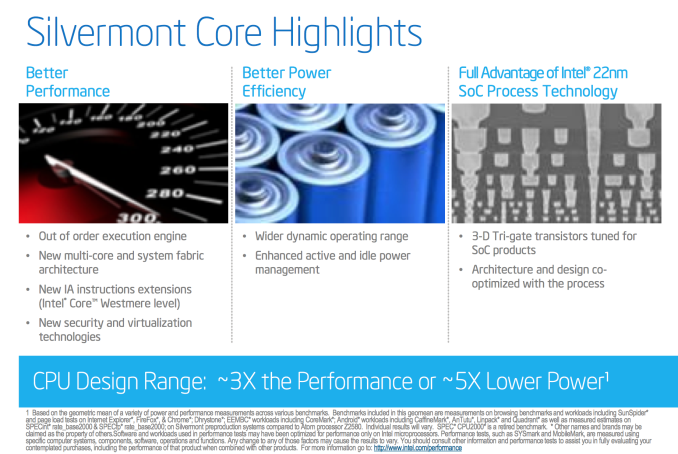
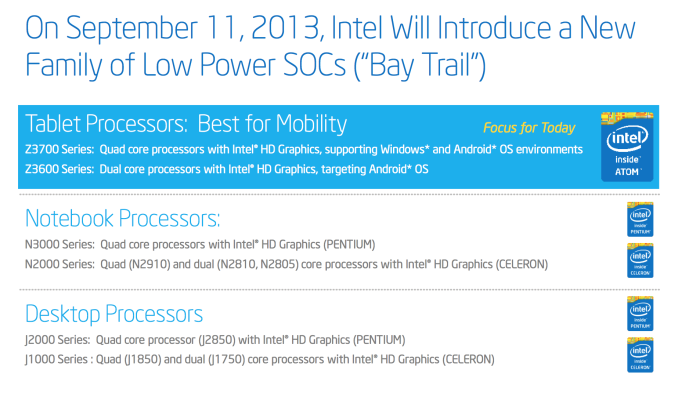
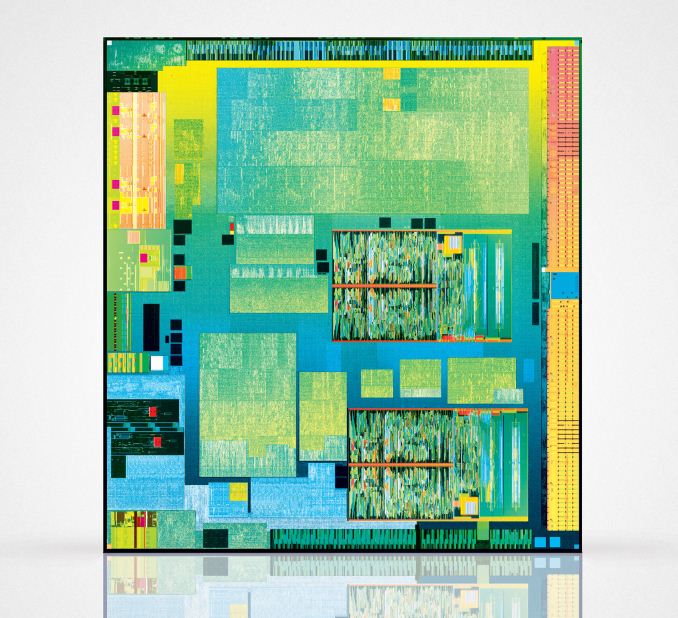
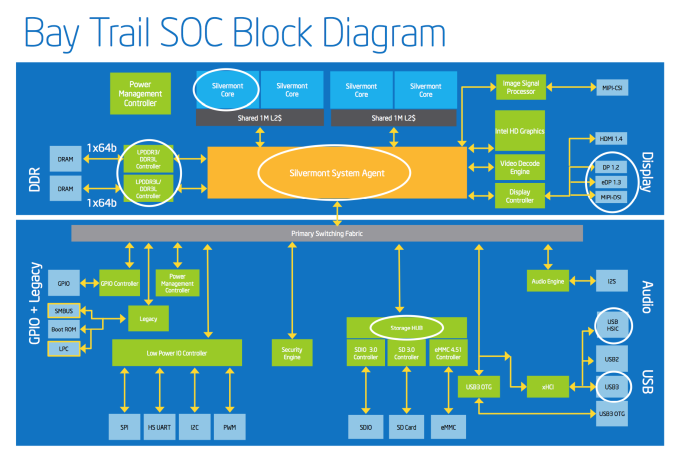
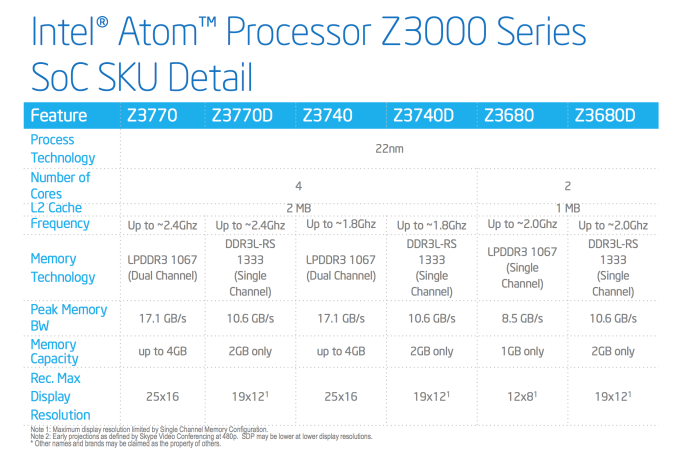
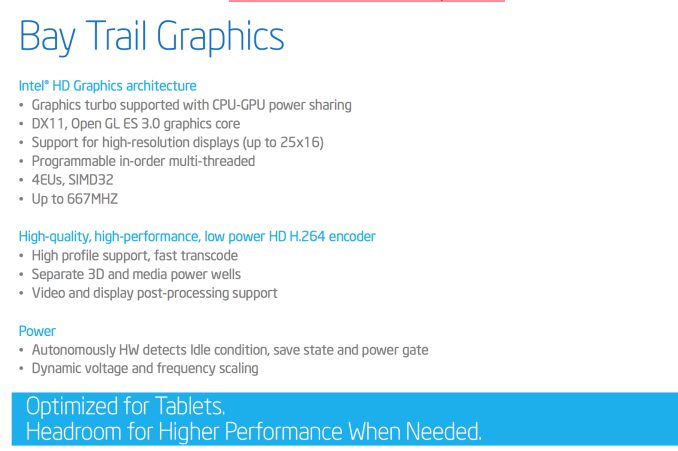
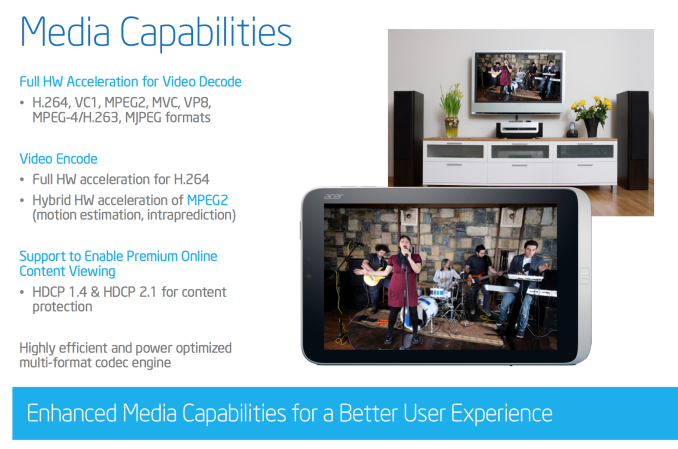








190 Comments
View All Comments
jfinely - Wednesday, September 11, 2013 - link
In the graphics the S800 is ahead but on the cpu side Baytrail dominates.So when you look at the SoC as a whole, it is too close to call.
The difference maker could be the energy consumption
Baytrail should run less energy consumption
phoenix_rizzen - Monday, September 16, 2013 - link
Really? Have you seen the battery use benchmarks Anandtech has done on the S800 in a phone form-factor? If not, go read through some of them. The S800 SoC doubles, sometimes triples, the S4Pro and S600 SoC battery life. And that's in a phone! Add in the extra thermal headroom of a tablet, along with the larger battery of a tablet, and I fail to see how Bay Trail can compete.zeo - Thursday, September 19, 2013 - link
The SD800 is limited in a phone and not running at the full possible performance and so is using a lot less power than it would in a tablet! Not to mention the smaller, typically around 720P screen on the phone versus 1080P on the tablet also tends to reduce power consumption for the phone...Really, the Clover Trail was already shown by Anandtech to be more energy efficient than many Cortex A9 ARM SoCs like the Tegra 3. While Bay Trail improves that power efficiency by about 5x!
Even while providing over twice the performance of Clover Trail and with double the number of cores, the Bay Trail still only uses about the same or less power than Clover Trail.
Besides, the phone optimized Merrifield for ATOM isn't out yet... So you're comparing the phone optimized SD800 to the tablet optimized Bay Trail T!
The Nokia Sirius 10" Tablet was going to be released with a SD800 and only claimed up to 10 hours run time! Bay Trail 10" tablet like the upcoming Asus T100 on the other hand claim up to 11 hours, albeit with a lower resolution screen!
While Anandtech showed extremely good performance per watt for Bay Trail in this review...
So at the very least they're very competitive on power efficiency and it's not a issue as you suggested!
Nagorak - Wednesday, September 11, 2013 - link
Well, you know, even if that were true, the point would be it's made by Intel and not Qualcomm. Intel doesn't get money from Snapdragon CPU sales, hence their interest in making their own CPU.In terms of CPU performance, it looks to me like Intel has really delivered here, but the graphics performance is still holding them back. Still it's hard to say Snapdragon smokes the new Atom. At worst they trade wins depending on whether it's CPU or GPU.
jasonelmore - Thursday, September 12, 2013 - link
i lol'd thankszeo - Wednesday, September 11, 2013 - link
Six months? Both Toshiba and Dell already announced 8" Bay Trail Tablets that will be released by the end of October of this year!Asus also announced a T100 2 in 1 tablet with keyboard dock... And you can't run the full range of software on a ARM SoC, but Intel can run any flavor of Windows, Android, Linux, or even OSX... They're also scaling up to higher end versions with even more performance that'll be low cost alternatives to Haswell...
fteoath64 - Thursday, September 12, 2013 - link
Same impression I got. For Intel to spend another 2 years to retool Atom to this stage yet, outgunned by both S800 and Tegra4 is really a POOR showing for the king of CPUs!. Many have said, just lay Atom to rest and continue with Haswell core "slash n burn" to cut down on power consumption and replace the pathetic MediaHD gpu with a variant of Rouge6 from Imagineering. Just as what Apple has done. The fact that Intel kept wanting to retain x86 compatibility shows, its constraints to out-do Arm in this low power game. Even on 22nm process the results are way LESS than passing grade (I would give 45% mark which is a FAIL still). Marginal but fail no doubt!. This chip should have been out 3 years ago and things might not have looked this bad. I guess Intel going with Quark might spur something useful. But I doubt it as Arm M3 is a mighty little thing just as hard to crack as the Cortex brothers .... Nice try Intel but fail still. Sorry.tech4real - Thursday, September 12, 2013 - link
if you read the results carefully, you can clearly see this atom's CPU muscle is stronger than S800.As for Tegra4 in Shield, please remember it's a fan device(meaning the power budget is >5W, a lot higher than this baytrail device), which makes the performance comparison unfair. Even then, some reviews find that baytrail trades blows with shield. To me, it shows significant perf/W advantage for silvermont core against both krait and A15.
you can find more benchmark results at:
http://techreport.com/review/25329/intel-atom-z300...
http://www.pcper.com/reviews/Processors/Intel-Atom...
monstercameron - Friday, September 13, 2013 - link
this tested baytrail platform was an intel prototype, so comparing it to a shipping product is a bit skewed, also tegra 4 can be passively cooled, it is just that it needs active cooling to keep its performance stable in the shield formfactor. Note that the tegra 4 has a better gpu than baytrail [higher performance higher power] which might be adding to the overall power draw.tech4real - Friday, September 13, 2013 - link
i agree on the point it's an intel prototype, so to be fair we need to wait till next month to really try on a shipping baytrail-T product. But as for tegra 4, my sources are saying even with CPU only heavy load(to remove the GPU effect), its power dissipation is still too high. Thus makes tegra4 pretty weak in terms of perf/W.I am sure we will get the clear picture next month as they come out.